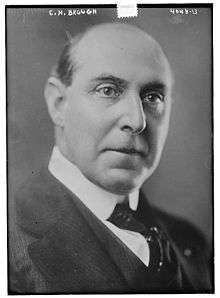Charles Hillman Brough
| Charles Hillman Brough | |
|---|---|
 | |
| 25th Governor of Arkansas | |
|
In office January 10, 1917 – January 11, 1921 | |
| Preceded by | George Washington Hays |
| Succeeded by | Thomas Chipman McRae |
| Personal details | |
| Born |
July 9, 1876 Clinton, Hinds County Mississippi, U.S. |
| Died |
December 26, 1935 (aged 59) Washington, D.C., U.S. |
| Resting place | Roselawn Memorial Park in Little Rock, Arkansas |
| Political party | Democratic |
| Alma mater |
Mississippi College |
| Profession | Professor; Lawyer |
| Religion | Baptist |
Charles Hillman Brough (9 July 1876 – 26 December 1935) was the 25th Governor of the U.S. state of Arkansas from 1917 to 1921.
Biography
Charles Brough was born in Clinton in Hinds County in central Mississippi. In 1894, he graduated from Mississippi College in Clinton. He earned his Ph.D. in 1898 from Johns Hopkins University in Baltimore, Maryland. He graduated from the University of Mississippi Law School in 1902. He taught at Mississippi College and the former women's institution, Hillman College, also in Clinton, Mississippi, and then the University of Arkansas at Fayetteville. He was a deacon in the Baptist Church.
Brough was elected governor in 1916. He defeated attorney Wallace Townsend, an Iowa native who later served as the long-term Republican national committeeman from Arkansas. Townsend made another unsuccessful gubernatorial bid in 1920 against Brough's successor, Thomas Chipman McRae.
During the Brough administration, the state reformatory for women was founded and a girl's industrial school was opened. He signed into law a bill which allowed women to vote in primary elections. Under Brough, Arkansas became the only southern state to allow women's suffrage prior to the 19th Amendment. Brough, a liberal Democrat, publicly supported anti-lynching laws. He was reelected as governor in 1918, when the Republican Party endorsed Brough against the Socialist Clay Fulks.
In 1919, Brough requested federal troops to stop the Elaine Race Riot in Elaine in Phillips Countyu in eastern Arkansas, and accompanied the troops to the scene.
Brough was a personal friend of the Woodward family and was an early influence on prominent southern historian C. Vann Woodward.
Brough served as the director of the Public Information Bureau from 1925 to 1928 and in 1929 as president of Central Baptist College in Conway, Arkansas. He chaired the Virginia-District of Columbia Boundary Commission from 1934 to 1935. Brough was also a Civitan.[1] Brough also unsuccessfully ran for the U.S. Senate in 1932, losing in the Democratic Primary to Senator Hattie Caraway.
Brough died in Washington, D.C. Like many other Arkansas governors, he is interred at the Roselawn Memorial Park Cemetery in the capital city of Little Rock.
Asked how to pronounce his surname, he told The Literary Digest: "Pronounced as if it were spelled bruff." (Charles Earle Funk, What's the Name, Please?, Funk & Wagnalls, 1936.)
See also
References
- ↑ Leonhart, James Chancellor (1962). The Fabulous Octogenarian. Baltimore Maryland: Redwood House, Inc. p. 277.
Further reading
- Cortner, Richard, A Mob Intent On Death, ISBN 0-8195-5161-9
External links
- Encyclopedia of Arkansas History & Culture entry: Charles Hillman Brough
| Political offices | ||
|---|---|---|
| Preceded by George Washington Hays |
Governor of Arkansas 1917–1921 |
Succeeded by Thomas Chipman McRae |
